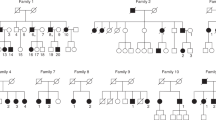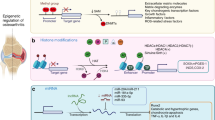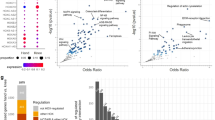Abstract
The death receptor 3 (DR3) gene is a member of the apoptosis-inducing Fas gene family. In the current study, fluorescence in situ hybridization (FISH) and Fiber-FISH revealed the existence of a second DR3 gene ∼200 kb upstream of the original DR3 gene. The existence of the duplicated DR3 gene was confirmed by sequencing the corresponding human artificial chromosome clones as well as with quantitative PCR that measured the ratio of the DR3 gene mutation (Rm), intrinsic to rheumatoid arthritis (RA) patients, by simultaneous amplification of the normal and mutated DR3 sequences. The DR3 gene duplication measured by FISH was found to be more frequent in patients with RA as compared to healthy individuals. We therefore surmise that the human DR3 gene can be duplicated and that this gene duplication is more prevalent in patients with RA.
This is a preview of subscription content, access via your institution
Access options
Subscribe to this journal
Receive 6 digital issues and online access to articles
$119.00 per year
only $19.83 per issue
Buy this article
- Purchase on Springer Link
- Instant access to full article PDF
Prices may be subject to local taxes which are calculated during checkout



Similar content being viewed by others
References
Locksley RM, Killeen N, Lenardo MJ . The TNF and TNF receptor superfamilies: integrating mammalian biology. Cell 2001; 104: 487–501.
Kitson J, Raven T, Jiang YP et al. A death-domain-containing receptor that mediates apoptosis. Nature 1996; 384: 372–375.
Chinnaiyan AM, O'Rourke K, Yu GL et al. Signal transduction by DR3, a death domain-containing receptor related to TNFR-1 and CD95. Science 1996; 274: 990–992.
Marsters SA, Sheridan JP, Donahue CJ et al. Apo-3, a new member of the tumor necrosis factor receptor family, contains a death domain and activates apoptosis and NF-κB. Curr Biol 1996; 6: 1669–1676.
Shiozawa S, Hayashi S, Tsukamoto Y et al. Identification of the gene loci that predispose to rheumatoid arthritis. Int Immunol 1998; 10: 1891–1895.
Shiozawa S, Hashiramoto A, Kawasaki H et al. Evidence for functional variation of the death receptor 3 (DR3) gene that inhibits apoptosis and predisposes to progressive joint destruction in rheumatoid arthritis. submitted for publication.
Grenet J, Valentine V, Kitson J, Li H, Farrow SN, Kidd VJ . Duplication of the DR3 gene on human chromosome 1p36 and its deletion in human neuroblastoma. Genomics 1998; 49: 385–393.
Gururajan R, Lahti JM, Grenet J et al. Duplication of a genomic region containing the Cdc2L1-2 and MMP21-22 genes on human chromosome 1p36.3 and their linkage to D1Z2. Genome Res 1998; 8: 929–939.
Suto Y, Ishikawa Y, Hyodo H, Uchikawa M, Juji T . Gene organization and rearrangements at the human Rhesus blood group locus revealed by fiber-FISH analysis. Hum Genet 2000; 106: 164–171.
Kemper O, Derré J, Cherif D, Engelmann H, Wallach D, Berger R . The gene for the type II (p75) tumor necrosis factor receptor (TNF-RII) is localized on band 1p36.2-p36.3. Hum Genet 1991; 87: 623–624.
Fonatsch C, Latza U, Dürkop H, Rieder H, Stein H . Assignment of the human CD30 (Ki-1) gene to 1p36. Genomics 1992; 14: 825–826.
Latza U, Dürkop H, Schnittger S et al. The human OX40 homolog: cDNA structure, expression and chromosomal assignment of the ACT35 antigen. Eur J Immunol 1994; 24: 677–683.
Schwarz H, Arden K, Lotz M . CD137, a member of the tumor necrosis factor receptor family, is located on chromosome 1p36, in a cluster of related genes, and colocalizes with several malignancies. Biochem Biophys Res Commun 1997; 235: 699–703.
Ohno S . Evolution by Gene Duplication. Springer-Verlag: Berlin, 1970.
Lynch M, Conery JS . The evolutionary fate and consequences of duplicate genes. Science 2000; 290: 1151–1155.
Parra I, Windle B . High resolution visual mapping of stretched DNA by fluorescent hybridization. Nat Genet 1993; 5: 17–21.
Fidlerová H, Senger G, Kost M, Sanseau P, Sheer D . Two simple procedures for releasing chromatin from routinely fixed cells for fluorescence in situ hybridization. Cytogenet Cell Genet 1994; 65: 203–205.
Germer S, Holland MJ, Higuchi R . High-throughput SNP allele-frequency determination in pooled DNA samples by kinetic PCR. Genome Res 2000; 10: 258–266.
Arnett FC, Edworthy SM, Bloch DA et al. The American rheumatism association 1987 revised criteria for the classification of rheumatoid arthritis. Arthritis Rheum 1988; 31: 315–324.
Acknowledgements
We thank Professor J Inazawa and Dr F Saito-Ohara at the Tokyo medical and dental University for their technical advise on FISH and Fiber-FISH, and Drs Y Konishi, H Kawasaki, Y Miura, K Komai and K Murayama at Kobe University for useful advice. We also thank Dr M Lamphier for critical reading of the manuscript. This study is expected to be a doctoral thesis of KO. This investigation was supported in part by a Grand-in-Aid for Scientific Research of the Ministry of Education, Culture, Sports, Science and Technology of Japan, Nos. 14657117 to KO and 13204059 to SS. This research was also supported by a grant for 21st Century COE Program, ‘Center of Excellence for Signal Transduction disease: Diabetes Mellitus as Model’ from the Ministry of Education, Culture, Sports, Science and Technology of Japan to SS.
Author information
Authors and Affiliations
Corresponding author
Rights and permissions
About this article
Cite this article
Osawa, K., Takami, N., Shiozawa, K. et al. Death receptor 3 (DR3) gene duplication in a chromosome region 1p36.3: gene duplication is more prevalent in rheumatoid arthritis. Genes Immun 5, 439–443 (2004). https://doi.org/10.1038/sj.gene.6364097
Received:
Revised:
Accepted:
Published:
Issue Date:
DOI: https://doi.org/10.1038/sj.gene.6364097
Keywords
This article is cited by
-
Beyond TNF: TNF superfamily cytokines as targets for the treatment of rheumatic diseases
Nature Reviews Rheumatology (2017)
-
TL1A in the inflammatory network in autoimmune diseases
Nature Reviews Rheumatology (2010)



